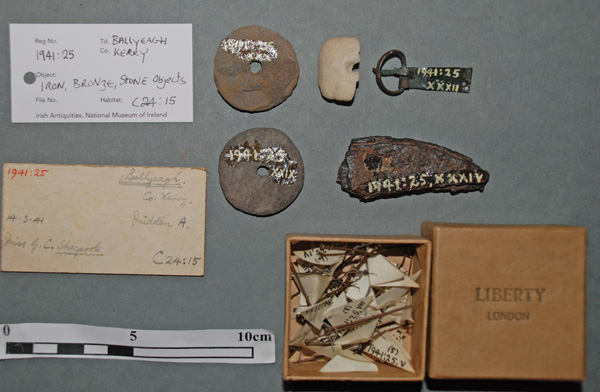1884-1966
Miss Gwendoline Clare Stacpoole: An Unsung Heroine of Irish Archaeology
Celebrating the contribution to Irish archaeology as one of its unsung heroines, Miss Gwendoline Clare Stacpoole.
By Sharon Weadick
Gwendoline Stacpoole was born on 8 June 1884 at Edenvale House, Co. Clare. She never married and died 27 October 1966. She was the niece and protégée of one of the greatest Irish antiquarians, Thomas Johnson Westropp. Her uncle introduced ‘Gwenny’ to Irish archaeology at a young age and she assisted him in surveying and photographing archaeological monuments around the country. On 16 April 1904 she became a member of the Royal Society of Antiquaries of Ireland. She remained an active member of the society all of her life.
Stacpoole’s collections in the National Museum of Ireland
While her uncle’s greatest interest lay with field monuments, Gwendoline’s own passion was for archaeological objects. During her lifetime she spent much of her time field-walking in the sandhills and ploughed fields along the east coast, from Carlingford Lough to Dalkey Island, and on the west coast in Donegal, Mayo, and Kerry, collecting surface finds. Over the years she amassed a large collection of archaeological finds, which she donated both to the Museum and to Professor G.F. Mitchell of Trinity College. Mitchell later donated his collection, which included Stacpoole’s collection, to the Museum.
Although Stacpoole’s collection is dominated by lithics, she also collected pottery, iron and bronze objects, glass beads and coins. To date, the Inventory Team have catalogued almost 3,500 objects from her collection. This excludes possibly the same number of objects again that came into the Museum via the Mitchell Collection, her coin collection, and the Asante copper alloy gold weights, that she jointly presented to the Museum with her friend Miss Margaret Brodigan.

Figure 2: A collection of finds recovered by Miss Stacpoole in the Sandhills at Ballyeagh, Co. Kerry
Stacpoole’s contribution to Irish archaeology
Compared to today’s field-collecting methodologies, Stacpoole’s methods were somewhat unsystematic. This said, her collections are still very much valued and have increased our evidence of the earliest settlers in Ireland.
The introduction of scientific archaeological excavation in Ireland in the late 1930s marked the end of antiquarianism. Stacpoole straddled the old and the new. She did not limit herself to field-walking but also worked on several excavations including Lough Gara (E20), Co. Sligo, Fourknocks, Dalkey Island, Co. Dublin, to name a few. According to Professor George Eogan, who worked with her on several excavations, she had an expert eye for spotting finds. He also acknowledged her for highlighting the importance of retaining lithics found on the archaeological excavations as their significance at that time was often overlooked.
In her lifetime she only published one article relating to her work in archaeology, ‘The Larnians of County Dublin’, an article for which she was awarded the Gold Medal by the Old Dublin Society. However, Liversage gives a synopsis of Stacpoole’s collections on the east coast in his article ‘A note on the occurrence of Larnian Flints on the Leinster Coast’. See below for full references to these articles.
Stacpoole the person
Gwendoline’s article is a refreshing read and even this one article gives us a window to the person she was. She was insightful, intelligent and witty. She had a romantic but realistic perception of the lives of past peoples. She had a great appreciation and knowledge of the Irish landscape and an inspirational fascination for archaeology. Gwendoline saw beyond the mere objects. She not only describes the flint and how it was worked but tells the story of the lives of the people who made and used the flint tools; the structure of their homes, what they ate and wore, suggests what language they spoke and the difficulties they met in their daily lives.
To those who knew her she was a woman of spirit and independence who was happiest driving through the countryside on excursions. Gwendoline’s contribution to Irish archaeology goes beyond the objects she collected. The Inventory Team were introduced to her early on in the project and five years on our appreciation of her has grown. In cataloguing her collections we feel we are not just acquainted with the artefacts she picked from the ground but with the lady herself.
Learn more...
Objects from the Stacpoole collection are not on public display but are in the Museum’s reserve collection.
However, artefacts from the Mitchell Collection are on display in the Prehistoric Ireland exhibition.
References
-
Liversage, G.D. 1961. ‘A Note on the Occurrence of Larnian Flints on Leinster Coast’ in JRSAI, 91 No. 1, 109-116.
-
Stacpoole, G.C. 1962. ‘The Larnians of Count Dublin’ in Dublin Historical Record, 18 No. 2, 34-44.
-
Ashe Fitzgerald, M. 2006. Thomas Johnson Westropp (1860-1922). UCD.
Acknowledgements
Thanks are due to George Stacpoole and Professor George Eogan.
Location:
Miss Gwendoline Clare Stacpoole: An Unsung Heroine of Irish Archaeology is located at:
In Storage
Previous artefact:
Next artefact:
